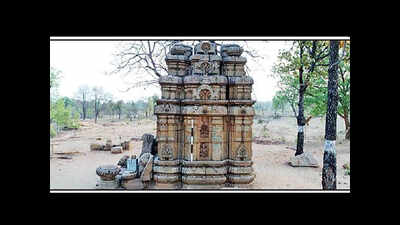- News
- City News
- bhopal News
- Madhya Pradesh: Swastika-shaped 6th century stupas found in Singrauli
Trending
This story is from April 1, 2019
Madhya Pradesh: Swastika-shaped 6th century stupas found in Singrauli

11 swastika-shaped stupas from 6th century were found in the deep forests of Singrauli.
BHOPAL: Archaeological Survey of India (ASI) has made a startling discovery of 11 'swastika-shaped' stupas, dating to 6th century AD, at a place called Buddha Danda - locally known as Bodh Dand - in the deep forests of Madhya Pradesh's Singrauli.
During the digging of Kalachuri Dynasty temples, which yielded surprises of their own recently - including a brick carrying the engraving of a "foreign face" and an extremely rare Vishnu statue - ASI was intrigued by curious mounds nearby.These turned out to be the stupas.
But ASI's Temple Survey Project (North India) team was dismayed to find that the site had been damaged by treasure hunters. The ASI team, under Dr Madhulika Samanta, went into the jungles of Singrauli's eastern Sarai Range to study two Kalachuri Dynasty temples discovered by Prof AK Singh of Rewa University in 2000.
The archaeologists were surprised to find curious mounds of bricks, heavily disturbed at their centre. When the team started working on them, they realised they were stupas of unique shapes.
"The purpose of these stupas is unknown as their centres are heavily disturbed by recent diggings by villagers, but the associated remains indicate a Shaivite lineage - which is surprising since the place name suggests its association with
"It is also the time when Adi Shankaracharya was leading a revival of Hinduism in India and several Shaivite sects flourished in this region. One of the most important sects was the 'Matta-Mayuri' cult, which believed in assimilation of different sects," Dr Samanta added.
Though in a dilapidated condition, they have tiered shikharas, generally found in south India. ASI officials said Kalachuri kings had close association with Rashtrakuta rulers of Karnataka by marriage and there are inscriptions which say that the Rashtrakuta king Amoghvarsha visited this part of the country to get his daughter married.
The ASI team has completed the structural cleaning of these stupas and even shot a short documentary on it.
Read this story in Bengali
During the digging of Kalachuri Dynasty temples, which yielded surprises of their own recently - including a brick carrying the engraving of a "foreign face" and an extremely rare Vishnu statue - ASI was intrigued by curious mounds nearby.These turned out to be the stupas.
But ASI's Temple Survey Project (North India) team was dismayed to find that the site had been damaged by treasure hunters. The ASI team, under Dr Madhulika Samanta, went into the jungles of Singrauli's eastern Sarai Range to study two Kalachuri Dynasty temples discovered by Prof AK Singh of Rewa University in 2000.
The archaeologists were surprised to find curious mounds of bricks, heavily disturbed at their centre. When the team started working on them, they realised they were stupas of unique shapes.
The naturally undulating topography had been used by the builders 1,300 years ago to erect these stupas. The natural mounds are capped by six to ten courses of stone and arranged in a swastika pattern, Dr Samanta said. Six types of bricks were used in these stupas and the bricks at the centre have hoof marks depicted on them. An inscription found nearby indicates the date of these remains to 6th-7th century AD.
"The purpose of these stupas is unknown as their centres are heavily disturbed by recent diggings by villagers, but the associated remains indicate a Shaivite lineage - which is surprising since the place name suggests its association with
Buddhism," Dr Samanta said.
"It is also the time when Adi Shankaracharya was leading a revival of Hinduism in India and several Shaivite sects flourished in this region. One of the most important sects was the 'Matta-Mayuri' cult, which believed in assimilation of different sects," Dr Samanta added.
Though in a dilapidated condition, they have tiered shikharas, generally found in south India. ASI officials said Kalachuri kings had close association with Rashtrakuta rulers of Karnataka by marriage and there are inscriptions which say that the Rashtrakuta king Amoghvarsha visited this part of the country to get his daughter married.
The ASI team has completed the structural cleaning of these stupas and even shot a short documentary on it.
Read this story in Bengali
End of Article
FOLLOW US ON SOCIAL MEDIA










